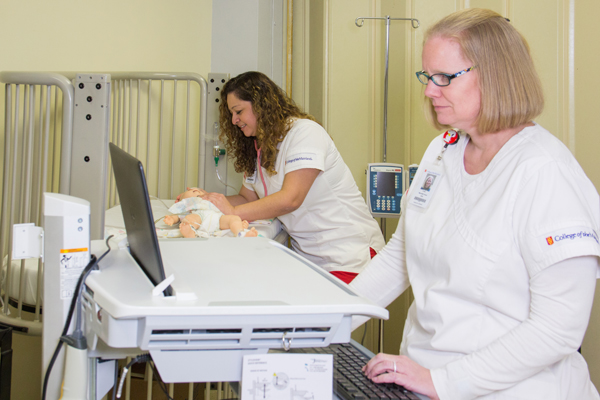Nursing robots breathe, talk and give birth

When students walk into the College of the Mainland nursing simulation lab, they hear a piercing newborn cry – but no baby is in sight.
It’s one of the new COM nursing robots – representing an infant, pregnant woman and surgical patient – that allow nursing students to hear heart beats, discern symptoms and measure breathing.
“It's a representation of what you might see in certain situations. The baby breathes. The chest goes up and down. If that baby has a murmur, we are able to hear the heart murmur and what it sounds like,” said student Ashley Yarbrough, of Houston. “We have everything to simulate the real world.”
One robot can simulate the birthing process.
“During a clinical rotation, there can be a patient who comes in already in labor. Students can be with that patient all day and then their shift ends and there’s still no baby. Manikins can ‘give birth’ several times a day. All students have the same experience,” said Mary Amanda Ordonez, interim director of nursing. “We can also program these manikins to have complications that students may not see while they are in school.”
The robots supplement students’ hours spent in clinicals at hospitals and other health care facilities.
“They can breathe, talk and have vital signs. They are more human than robotic,” said Hammer. “Students learn how to respond to emergencies.”
The equipment was purchased with a $209,760 grant through the Jobs and Education for Texans (JET) grant program. The JET grant program focuses on projects that target high-demand jobs in new or emerging industries.
“By providing JET funding to our schools, we are able to train workers with the skills needed for today’s job market and meet employers’ demand for skilled labor,” said Texas Workforce Commissioner Representing Employers Ruth R. Hughs. “These grants will help keep our Texas businesses competitive and our economy growing.”
The COM Associate Degree Nursing Program launched in 1972. The program is designed to help each student succeed through interactive labs, faculty mentors and clinical rotations at state-of-the-art facilities. COM also offers a licensed vocational nurse to registered nurse transition track.
For more information on the COM Nursing Program, visit www.com.edu/nursing.
